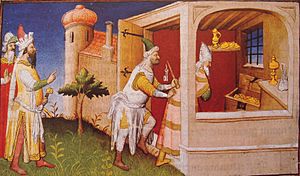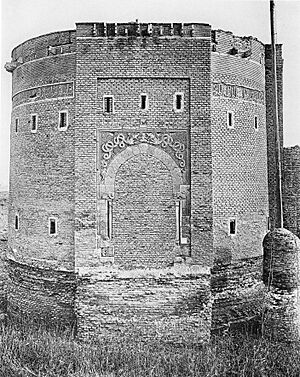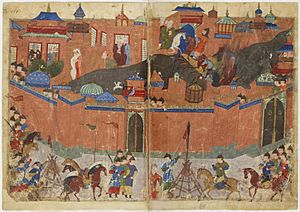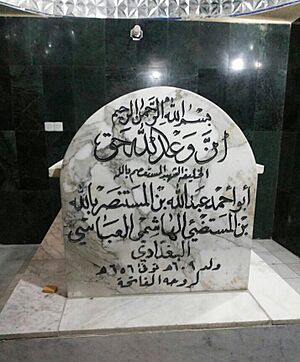- This page was last modified on 1 January 2026, at 00:05. Suggest an edit.
al-Musta'sim facts for kids
| al-Musta'sim Billah المستعصم بالله |
|||||
|---|---|---|---|---|---|
| Khalīfah Amir al-Mu'minin |
|||||
| Caliph of the Abbasid dynasty | |||||
| Reign | 5 December 1242 – 20 February 1258 (15 years 2 months 15 days) | ||||
| Predecessor | al-Mustansir | ||||
| Successor | Position abolished al-Mustansir bi'llah (caliph of Cairo) |
||||
| Born | 1213 Baghdad |
||||
| Died | 20 February 1258 (aged 45) Baghdad |
||||
| Burial | Al-Musta'sim Billah Mosque, Adhamiyah, Baghdad, Iraq | ||||
| Consort |
|
||||
| Issue | Abu'l-Abbas Ahmad Abu'l-Fadaʿil Abd al-Rahman Abu'l-Manaqib al-Mubarak Fatimah Khadijah Maryam A'ishah Karimah |
||||
|
|||||
| Dynasty | Abbasid | ||||
| Father | al-Mustansir | ||||
| Mother | Hajir | ||||
| Religion | Sunni Islam | ||||
Al-Musta'sim Billah was the 37th and last caliph (leader) of the Abbasid dynasty. His full name was Abu Ahmad Abdallah ibn al-Mustansir bi'llah. He ruled from Baghdad, the capital, from 1242 until his death in 1258. His time as caliph ended when the powerful Mongol army invaded and destroyed Baghdad.
Contents
The Last Abbasid Caliph
Al-Musta'sim was born in 1213. His father was the previous Abbasid caliph, al-Mustansir. After his father passed away, Al-Musta'sim became the caliph in late 1242.
During his rule, Al-Musta'sim faced big challenges. One of the biggest threats was the Mongol Empire. The Mongols, led by Hulagu Khan, were conquering many lands. They had already taken over areas like Transoxiana and Khorasan.
Al-Musta'sim also had a disagreement with the Mamluks in Egypt. This happened when a woman named Shajar al-Durr became the ruler of Egypt. The Caliph in Baghdad did not approve of a woman ruling. In those days, a ruler needed the Caliph's approval to be seen as legitimate. To fix this, the Mamluks chose a man named Izz al-Din Aybak as their new Sultan. He then married Shajar al-Durr.
The Caliph also helped settle a conflict between the Mamluks in Egypt and the Ayyubids in Syria. He preferred a peaceful solution. Thanks to his efforts, an agreement was reached. This agreement gave the Mamluks control over parts of Palestine, including Gaza and Jerusalem. This helped the Mamluks gain more power and recognition for their rule.
The Mongol Invasion

Some stories say Hulagu (left) starved Al-Musta'sim to death among his treasures. This is likely not true.
In 1258, the Mongol army, led by Hulagu Khan, invaded the Abbasid lands. By this time, the Abbasid Caliphate only controlled Baghdad and its nearby areas. Hulagu's army surrounded Baghdad. They stopped people from leaving the city and killed those who tried to escape.
Baghdad was attacked on February 10, 1258. The caliph, Al-Musta'sim, was killed soon after. It is believed that the Mongols did not want to shed "royal blood." So, they wrapped him in a rug and trampled him to death with their horses. Many of his sons were also killed. One son survived and was sent away as a prisoner.
A famous traveler, Marco Polo, wrote a story about Al-Musta'sim's death. He claimed that Hulagu Khan found the caliph's huge treasure. Hulagu then locked Al-Musta'sim in his treasure room without food or water. He supposedly told him, "Eat of your treasure as much as you want, since you love it so much." However, many historians believe this story is not true.
The Siege of Baghdad

The Talisman Gate protected Baghdad's eastern walls during the siege.
Hulagu Khan sent a message to Al-Musta'sim. He demanded that the caliph surrender. But Al-Musta'sim refused. His main advisor, Ibn al-Alkami, encouraged him to resist. Some historians think Ibn al-Alkami might have lied to the caliph about how serious the Mongol threat was. He might have told Al-Musta'sim that other Muslim armies would come to help Baghdad.
Even though Al-Musta'sim refused to surrender, he did not prepare his city for war. He did not call for more soldiers to defend Baghdad. He also did not make the city's walls stronger. By January 11, the Mongols were very close to Baghdad. They surrounded the city from both sides of the Tigris River.
Al-Musta'sim finally sent out 20,000 cavalry (soldiers on horseback) to fight the Mongols. But the Mongols easily defeated them. The Mongols also broke dikes (walls) along the Tigris River. This flooded the land behind the Abbasid soldiers, trapping them.
The Attack
The Abbasid Caliphate was supposed to have 50,000 soldiers to defend Baghdad. This included the 20,000 cavalry Al-Musta'sim sent out. But these soldiers were quickly put together. They were not well-trained or well-equipped. The caliph had the power to ask other Muslim rulers for help, but he did not.
On January 29, the Mongol army began its siege of Baghdad. They built a fence and a ditch around the city. They used large machines like catapults to attack the city walls. By February 5, the Mongols had taken over a large part of Baghdad's defenses.
Al-Musta'sim realized his army could not win. He tried to talk to Hulagu, but Hulagu refused. About 3,000 important people from Baghdad also tried to negotiate with Hulagu, but they were all killed.
Five days later, on February 10, the city surrendered. But the Mongols did not enter until February 13. Then, they began a week of terrible destruction and killing.
Destruction and Aftermath
Many historical stories describe the cruelty of the Mongol conquerors. Mongol soldiers looted and destroyed mosques, palaces, libraries, and hospitals. Priceless books from Baghdad's libraries were torn apart. The famous House of Wisdom, a huge library with countless important documents and books, was completely destroyed. Some stories say the Tigris River turned red from the blood of the people killed. Citizens tried to run away, but Mongol soldiers stopped them and killed everyone, even children.
Caliph Al-Musta'sim was captured. He was forced to watch as his people were murdered and his treasures were stolen. As mentioned, he was killed by being trampled by horses. All but one of his sons were killed. The one surviving son was sent to Mongolia.
The smell of death and decay from the ruined city was so bad that Hulagu had to move his camp away. Baghdad remained a ruined city for many years. It slowly recovered some of its former glory later on.
After the destruction, Hulagu left 3,000 Mongol soldiers to help rebuild Baghdad. Later, a governor was appointed to rule the city. Hulagu's Christian wife, Dokuz Khatun, helped save the lives of Baghdad's Christian people.
The fall of Baghdad shocked the entire Muslim world. It marked the end of the Abbasid Caliphate as a powerful political and religious force. Later, the Mamluk Sultans in Egypt appointed new caliphs. But these caliphs had no real power. They were just symbolic leaders.
Legacy
Al-Musta'sim ruled for about 15 years. His death on February 20, 1258, marked the end of the Abbasid Caliphate's political power. Even though other caliphs were appointed later, they were mostly symbolic. They had little importance in the Muslim world.
See also
- Yaqut al-Musta'simi a famous calligrapher and secretary of al-Musta'sim.
- Mongol invasions of the Levant
|
Al-Musta'sim
Cadet branch of the Banu Hashim
Born: 1213 Died: 20 February 1258 |
||
| Sunni Islam titles | ||
|---|---|---|
| Preceded by Al-Mustansir |
Caliph of Islam Abbasid Caliph 5 December 1242 – 20 February 1258 |
Vacant
Title next held by
Abu’l-Qasim al-Mustansir |


